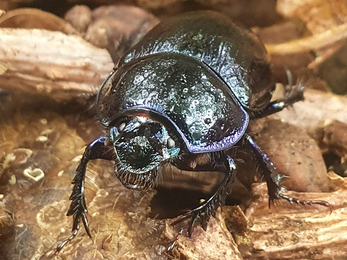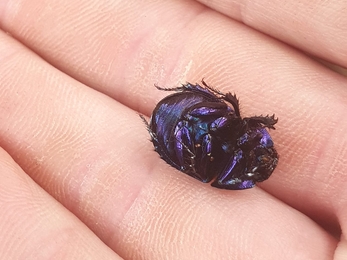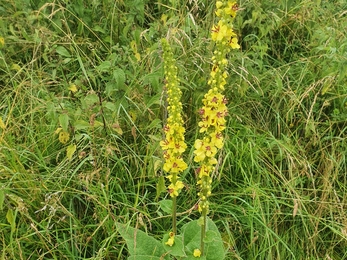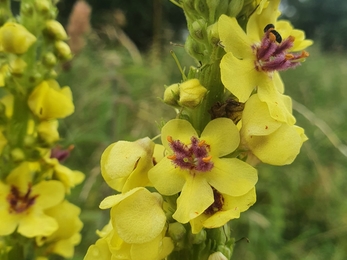Weekly wild news from our reserves - 30 July 2021
Purple emperor at Bull's Wood - Alex Lack
Bitterns continue to show at Carlton Marshes nature reserve. This beautiful bird was captured in flight recently by voluntary warden Gavin Durrant. A rare and shy heron, the bittern spends almost all its time hidden away in large reedbeds, where it feeds on eels and other fish. It has wonderfully camouflaged plumage, helping it to blend into the reeds. It can also stand motionless for long periods to avoid detection.
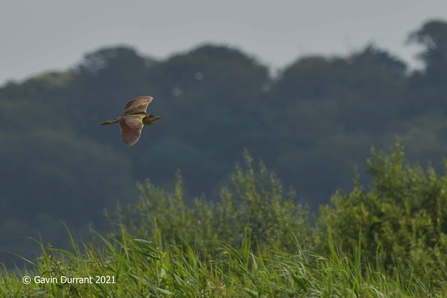
Bittern at Carlton Marshes – Gavin Durrant
Woodland dor beetle
This metallic dor beetle found at Old Broom Nature Reserve is a species of earth-boring dung beetle. They inhabit fresh areas of broadleaf, coniferous and mixed forests and feed on faeces, rotting fungi and tree sap. In spring, eggs are laid in chambers at the end of a corridor dug in the soil that is approximately 70–80cm long, in which faeces of herbivorous and omnivorous animals are placed to feed the larvae. The larvae overwinter and pupate in spring, requiring a year to complete the whole process.
Purple patch
The West Suffolk Reserves Team have been experiencing some memorable wildlife finds over the past few months and none more so than last week when, during a day at Bull’s Wood Nature Reserve replacing a field gate, an unexpected visitor flew into the cab of the truck and settled down on the handle of a bag. Populations of the purple emperor butterfly declined steadily during the twentieth century and is now restricted to some of the larger woods in southern England like Bradfield and the neighbouring Bull’s Wood. The adults are extremely elusive spending much of their time in the treetops and occur at low densities over large areas. The males occasionally descend to the ground, usually in mid-morning, where they probe for salts. Knowing how hard the team works, I can only imagine that bag handle having come into contact with sweaty palms on many an occasion. A treat for the purple emperor means a treat for us with this stunning close-up photo!
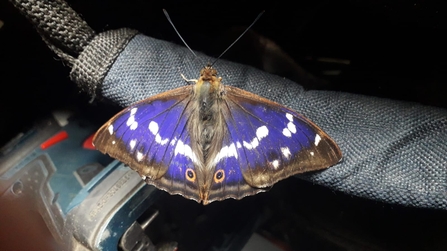
Purple emperor at Bull's Wood - Alex Lack
Meadow brown
This rather tatty meadow brown was seen at Mickfield Meadow recently. The medium-sized meadow brown is one of the commonest grassland butterflies, on the wing in the summer. It even flies in dull weather when other butterflies are inactive. Adults can be seen in large numbers, flying low over the grass and flowers. Caterpillars feed on a variety of grasses such as fescues, bents and meadow-grasses.
The meadow brown is mainly brown with washed-out orange patches on the forewings, with one eyespot on the forewing and none at all on the hindwings. The meadow brown also has only one small white 'pupil' in the eyespots, instead of two like the gatekeeper.
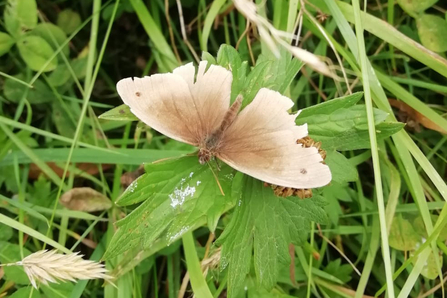
Meadow brown at Mickfield Meadow - Gabby King
Snape Marshes gets a trim
The South Suffolk team have been busy forage harvesting at Snape Marshes this week. We bail up the cuttings to feed livestock and to keep the nutrient level low to establish flowering next year. Our conservation grazing ponies were not fazed by the noisy tractor, they were too busy being frisky!
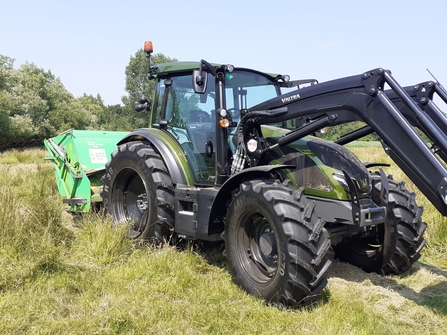
Forage harvesting at Snape with Ben's new pride and joy (shiny new tractor) to complement the grazing
Frisky ponies at Snape Marshes (https://youtu.be/qQxaBYUafjM)
Frisky ponies at Snape Marshes
Soft, strong and very long
Dark mullein is a biennial or short-lived perennial of road verges, hedge banks and other grassy places that are subject to occasional disturbance such as the shifting sands at Lackford Lakes. The main flowering period is from June to September but can continue into November if weather conditions are favourable. The value for wildlife of this striking plant is threefold. The flowers are a good pollen and nectar source for a wide range of insects, particularly bees. Numerous seed-eating animals including birds such as the goldfinch feed on the massive number of small seeds produced and the dead flowering stems provide hibernation sites for over-wintering invertebrates. There are many vernacular names given to dark mullein but a more modern and practical nickname is 'the Andrex plant' and its leaves have been used accordingly!
Shrew interruption
Our Learning Team meeting at Foxburrow Farm was interrupted this week when an exciting visitor joined proceedings.
Ipswich Learning Officer, Lucy, spotted one of the cracks in the yard starting to move and so immediately was off her seat ready to inspect who was about to join our meeting and was delighted to find it was a little shrew!
This individual was running underneath the yard floor along the crack and was collecting leaves that had settled on the surface. What a wonderful distraction!


